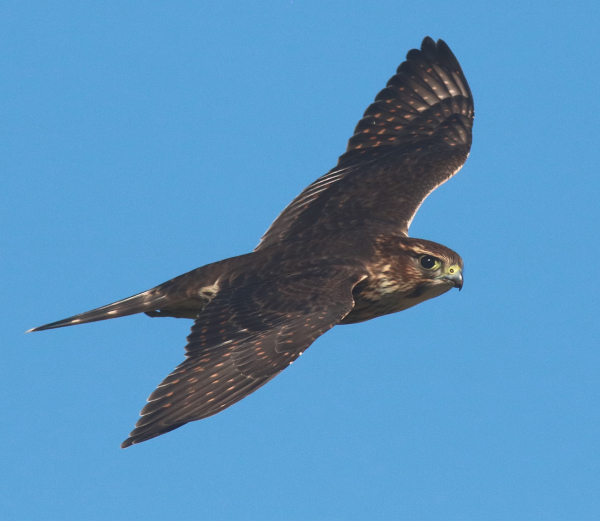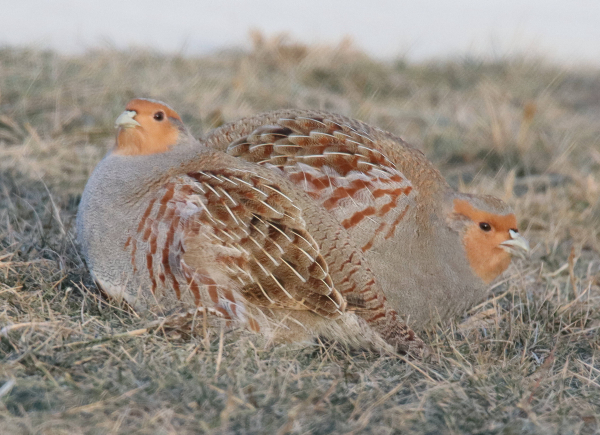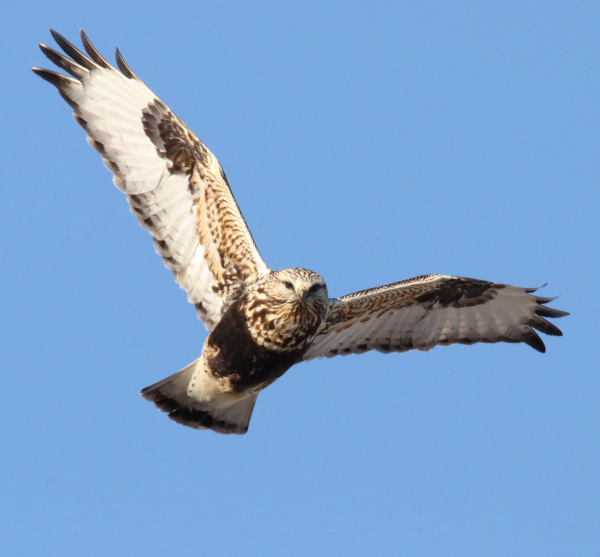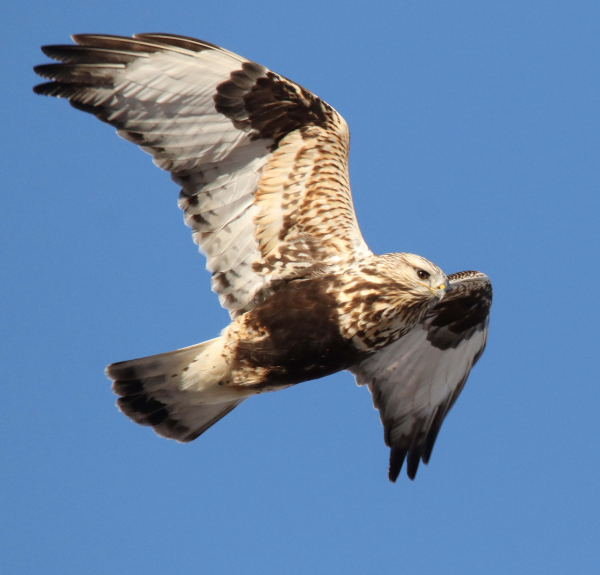
Seeing 2 Merlins the same winter day - the first bird of the day and the last - was highlighted by witnessing a spirited hunting pursuit just north of home.

Part of a covey of 10 Gray Partridges, these birds puffed their feathers out to create a body-warmed layer of air in response to the cooling afternoon temperatures.

Seeing Short-eared Owls again was a highlight of the week, with 1 owl and 2 Rough-legged Hawks sighted along the same 5-mile stretch of open grasslands south of the office.

More than once a local Rough-legged Hawk has winged directly toward my car, providing chances to photograph it in flight.

|
As I began a drive to Fargo last Wednesday, I was only a quarter-mile from home when a small falcon flew from a line of blue spruce trees – a Merlin on the wing! I was essentially already following it, but lost sight as the falconet flew low above an open field. That’s when a flock of 7 Rock Pigeons flushed from the field, giving me the impression they reacted to the falcon’s approach, but I didn’t expect the Merlin to pursue such big, strong birds and looked past the pigeons for the falcon to reappear. That’s when I saw the start of a chase: The Merlin was in close pursuit with a pigeon flying high, then speeding downward as the falcon closed in.
I lost sight of them, even though I turned my car around and followed the flight – but it certainly sharpened my senses as I resumed by mission. Providing more promise for this road trip was a Northern Shrike, hunting from an open perch. But January birding in the Northern Plains can be scant and spotty, and I didn’t see another bird until I reached Fargo. There I checked on the Gray Partridges I have been monitoring for about 18 months, and even before I made the last turn, I spied a covey feeding. I slipped into a position with the sun at my back where I could watch the partridges as they slowly foraged in my direction. The flock of 10 kept a low profile among the low-cropped plants as they fed in close association on what must have been very abundant grass and weed seeds.
Even though the area was now snow-free and it was fairly warm (20°F), the partridges extended their body plumage to hold body-warmed air close to their bodies. This made them look very round and neckless, and their heads looked small in comparison to their rotund bodies – quite different from than their usual birdy shapes. Just 100 yards to the west I encountered another flock of 11 Gray Partridges, similarly foraging very close to the ground, seemingly to avoid detection. I photographed birds in both flocks and searched for others in the area.
As the sun was low in the southwest, I looked for Rough-legged Hawks where I’ve seen them before along the southwest edge of Fargo, where fertile agricultural fields are giving way to the fast-growing city. I turned south into the fields and was surprised to see a low-flying Merlin zip across the road close to my auto, then vanish into the field again, probably conducting a late hunt for a Horned Lark or another songbird or rodent considering its coursing flight. The Merlin provided a quick jolt of excitement that made this a special trip, having seen 2 of the little falcons the same day – something I haven’t experienced in quite a while. Merlins are very special birds indeed.
When I left Fargo after some shopping, I watched for an owl along the stretch of highway where I observed a Short-eared Owl and a Snowy Owl during previous evening return trips, but no owls appeared in my headlights this time. However, 90 minutes later, not far from my return destination of home, I did see a Short-eared Owl take flight from the side of the pavement – an interesting sighting considering I hadn’t seen the species since the first week of December. Perhaps it showed promise for seeing more in my home range. Indeed, as I was returning from a short drive south of my office Friday afternoon, a Short-ear provided a nice surprise. I followed behind its hunting flight, trying a couple photos until it swept into a half-circle approach to a hilltop perch. I was able to take a few photos of it there before it vanished over the hill – perhaps landing in the tall grass where I couldn’t find it again. I searched the area a couple times, but it wasn’t flying above the tall grass; perhaps there will be more.
Before the owl encounter, I checked on a Rough-legged Hawk that I’ve been seeing periodically about 13 miles south of my office. Of course, it may be the same hawk or more than one, but it seems that it’s a single bird that is on a short-term winter territory, hunting from the same or nearby perches, and hovering on the hunt above the prairie grasslands surrounding the area. More than once the hawk has flown directly toward my car, providing chances to photograph it in flight and giving me the impression it is interested or inquisitive about the white car stopped along the road.
But Friday I didn’t see that particular Rough-leg during 2 drive-bys, yet I was especially surprised to see a dark morph Rough-leg a few miles farther south – at the location where I observed a dark morph a couple times the first week of December. Could it be the same bird? I took a couple long-range photos of it perched and as it flew to a second perch about a half-mile east to compare the photographs I took 5 weeks earlier to see if it might be the same bird. Considering that I drive this route regularly, I was very surprised that this identifiable black Rough-leg might have returned – or did it ever leave? These are the kinds of questions that add a little more depth to birding, and it's why I look for ways to identify individual birds by some plumage or behavioral traits that reveal some additional information about the bird and the species.
At home, the lone wintering Harris’s Sparrow continues to be a regular visitor to my platform feeder, and it’s fun to take closer looks of it with binoculars to see the subtle color patterns throughout its plumage and watching it raise its crest and tip its tail upward distinctively. Similarly, when the Dark-eyed Juncos appear it’s a little thrill, and same for the male Hairy Woodpecker and White-breasted Nuthatches. When individual birds visit your feeder regularly, it’s nice to feel a special connection with them, seeing them outdoors as you work – or should I say as I work. But birds like these provide something to look forward to, and to appreciate and savor week by week, month by month, or season by season.
Lately, the lively Blue Jays have been disconnected, and absent for about 6 days – from Monday to Sunday – which makes me wonder about their movements in the area. Then too, Sunday only a single Blue Jay visited, twice. When changes like these arise, it’s interesting and adds to trying to learn more about the birds in the area; in some cases it’s also about learning about the individuals themselves.
Over the weekend, a snow storm ruled out any birding beyond my windows, and when I drove what is becoming my regular route to the south, I didn’t see one bird, which was followed by a couple sub-zero nights. Even so, while wintering birds in the Northern Plains are few and far between, when you have such impressive species as Northern Shrikes, Short-eared Owls, Rough-legged Hawks, Merlins, and Bald Eagles to search for, it’s exciting when you do encounter these birds, and there is always the chance of seeing a Snowy Owl or another high plains visitor. You may be in an area where wintering birds abound, and if that’s the case: Enjoy the birding opportunities they present!
Article and Photos by Paul Konrad
Share your bird sightings and photographs at editorstbw2@gmail.com